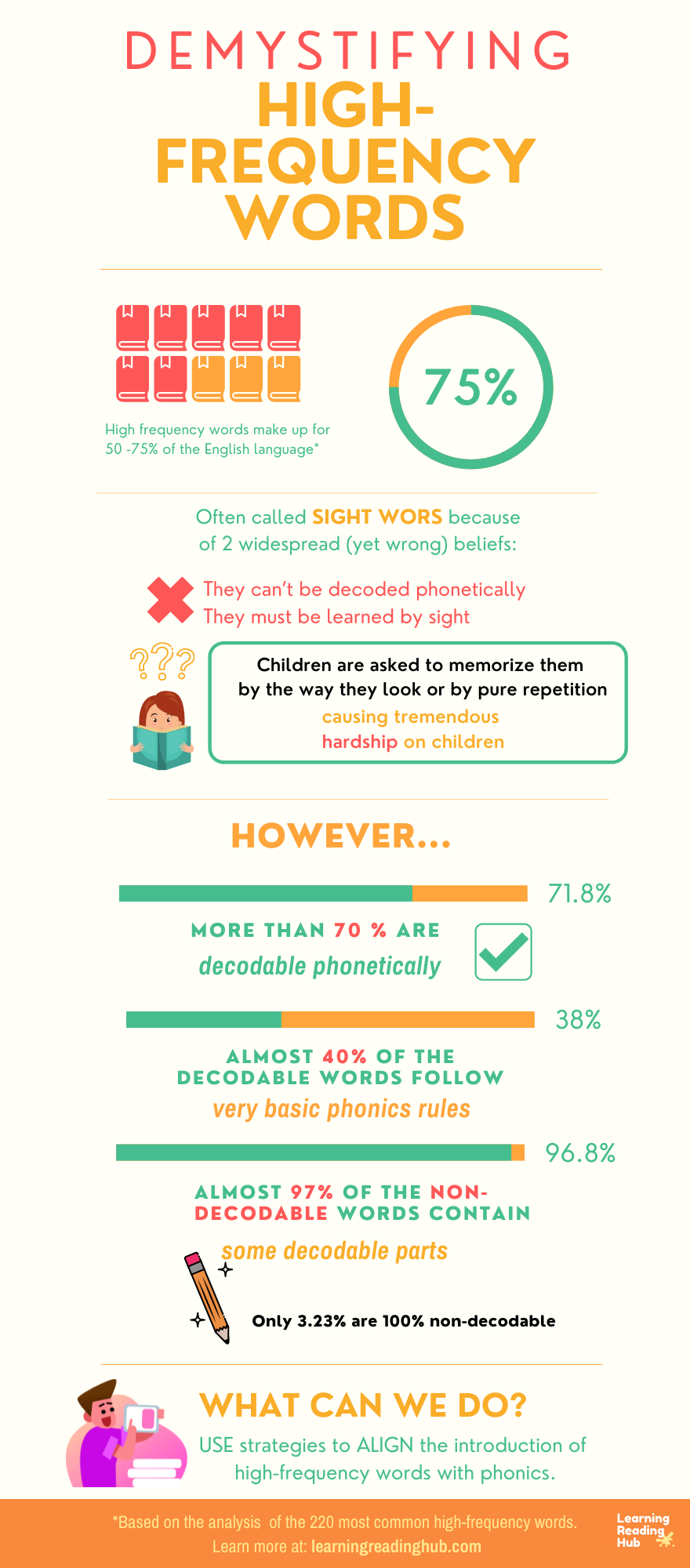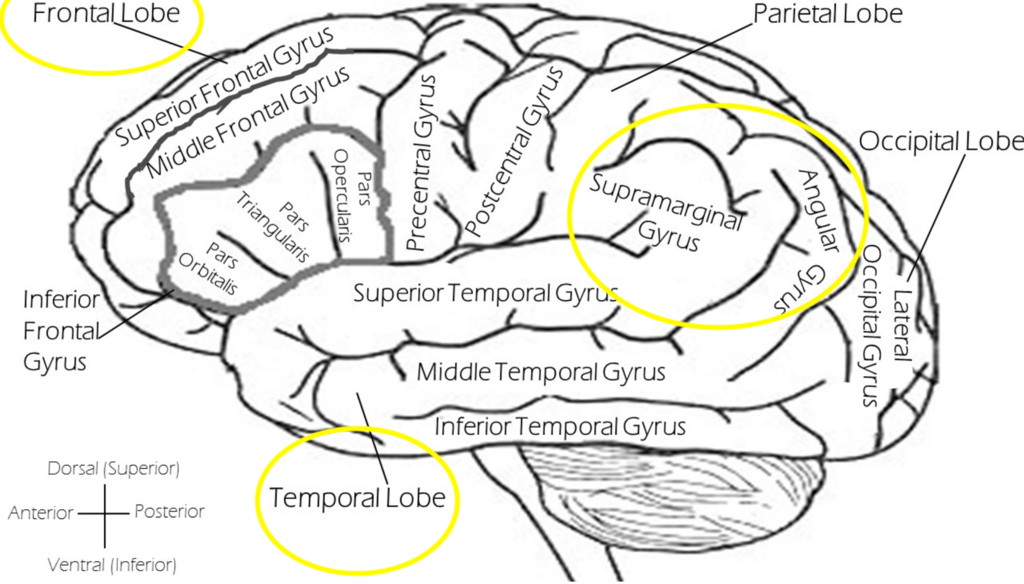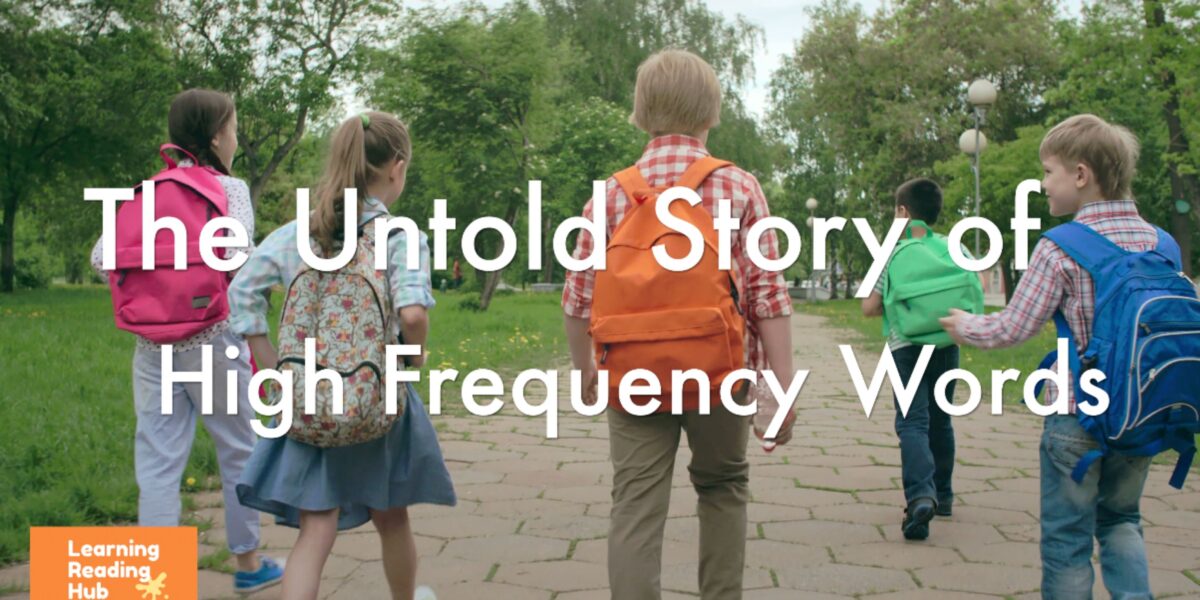WHAT WILL YOU LEARN ON THIS ARTICLE??
- High-Frequency words vs. Sight words
- INFOGRAPHIC: The Untold Story of High-Frequency Words
- TRUE or MYTHS? Common Beliefs around Sight words
- EVEN More Revealing Data!
- The 220 Most Commonly Used High-Frequency Words List
- The INS and OUTS of the analysis
- Recommended Resources
- The Video: The Untold Story of High-Frequency Words
High Frequency Words vs. Sight Words
High-Frequency words make up for up 75% of the words used in the English language found in schoolbooks, library books, newspapers, and magazines.
That is according Edward William Dolch, who compiled this famous list back in the 30’s after analysing the literature of the time. It is worth noting that Dolch was a major proponent of the whole word approach.
Other common high-frequency words (apart from Dolch’s list) used in the school system are: Fry Instant words, or a selection of words from specific reading programs/ curriculums.
High-frequency words are normally referred as sight words because of two common beliefs extremely rooted in society and in the education system:
- They can’t be sounded out, so they need to be learn by the way they look (by sight) or pure repetition.
- They have to be learned by sight and stored as images in our visual memory.
These 2 beliefs have major implications in the way these words have been being taught for decades now, and in the way we think these words are stored in our brain.
However, our analysis* of the 220 most commonly used high-frequency words reveals a different story…
The Infographic: Demystifying High-Frequency Words

Do you Want to share this Infographic On Your Site? Simply copy and paste the code below!
Share this Image On Your Site
Interested in knowing more?… keep Reading!
Common Beliefs around Sight words: True or Myths?
Ok, let’s go through the beliefs mentioned on the infographic together…
Based on the analysis and what modern science has found out, are they TRUE or are they MYTHS?
Belief #1:
High-frequency words can’t be sounded out, so they need to be learned by the way they look (by sight) or by pure repetition.
Is this truth or a myth?
Well, actually after an analysis of the 220 most-frequently used high frequency words list, the results are quite revealing…
More than 70 % (71.82 %) of these words are, in fact, decodable phonetically.
What’s more, among these decodable words, almost 40% (37.97%) follow very basic phonic rules.
So, even if it sounds unbelievable (because of the way we have been conditioned to believe), this belief is a myth.
Belief #2:
They have to be learned by sight and stored as images in our visual memory.
This belief implies that the way to memorize and store these words in our brain is as if they were pictures or photographs. In fact, visual memory has been traditional deemed as a key factor for learning to read.
Therefore, the key question is:
Do we really store words as if they were pictures in our brain?
AND…
Is that the best way (most effective way) to remember words and learn about their spellings?
For a long time (due again to how engrained the whole word approach has been on society) we have assumed so.
But: have you ever wondered what this assumption is based on?
Is it based on science or just pure speculation?
It turns out that it is based on speculation and, by no means, on the findings of what modern science has to say about how we learn to read or the specific parts of the brain that are involved in reading…
Brain scans show that the parts of the brain activated while performing visual memory tasks are different than the parts of the brain activated while reading.
These are the parts activated while reading:
- The temporal lobe: where we recognize sounds, and is responsible for Phonological Awareness.
- The frontal lobe: the part of the brain involved in speech production, reading fluency, grammar and comprehension.
- The angular and supramarginal gyrus: the phonological assembly, that integrates it all together, creating the brain circuits (synapses) to the different parts of the brain that are involved in the execution of reading.
All these parts involved work in harmony and synergy to produce the complex task of reading.

There is no evidence to suggest that visual memory has a role in word recognition /reading fluency once the letters and the connection between letters and sounds have been learned.
As reading instruction still assumes that we store words as visual images, students who struggle to remember words are many times presumed to have poor visual memory.
However, there is only a small relationship between visual memory and our capacity to store words for immediate retrieval while reading.
So, again, this belief a myth…
Unfortunately, this wrong belief has led to the popularity of many “look-say” instructional methods and resources.
ARE YOU CURIOUS TO KNOW EVEN MORE?
EVEN more revealing data!
Digging into our analysis of the 220 most commonly used high-frequency words, we find some more interesting (and revealing) data!:
-
- Only 11% of the decodable ones follow what I would consider very advanced phonics rules.
- Only around 3% of the non-decodable ones are, in fact, 100% non-decodable (meaning that nothing on the word makes sense phonetically). The 2 words (out of the ones analyzed) that make up for this 3.23% are: ‘of’ and ‘a’
- The most common occurrence among non-decodable high-frequency words is that around a third of the word is non-decodable. A few examples are: said, what, word, his, both, work… All of these words have 3 sounds, 1 of them presenting an unexpected spelling.
The 220 most commonly used High -Frequency Words
You can check the list of the words we analyzed below (even though there are some different versions of Dolch lists -including nouns, not including nouns, etc.-, we based our analysis on the suggested list by Reading Rockets on this excellent article about the topic)
Decodable (71.82%): at am an it in if on off up us had can ran him did will big six sit not got hot but run cut get yes red well let tell ten that with then them this much pick wish when which black and just must fast best went ask its jump help stop sing bring long thank think drink too for or start far her first hurt came take make made gave ate like ride five white been all call fall small ball know I he she be we me go so no my by fly try why play may say see green sleep keep three eat read clean right light own show grow out round found down now how brown look good new soon draw saw after never better under little over old cold hold find kind mind seven upon about around away myself open funny going yellow before every they want wash watch because
Non-decodable (28.18%): from a of you was said what the very your yours don’t pretty four their here two again who eight today could would should were are both one work word world buy guy his is as has have give live some come done to do into there where these those once blue glue clue true put full pull push walk talk any many
The ins and outs of the Analysis
Keen to know even more about the analysis and how we classified these words?
READ ON!
And for a print-out and even more information (including what parts are decodable and not, info on the phonics rules that these words follow and more), check The Golden Document for Understanding High-Frequency Words!
NOTE: Decodable words are classified by difficulty level (1- 4). Please, this is only for your reference, since I do not know what program you are using to teach your child to read! Ideally, you should introduce high-frequency words in line with the materials on the program you are following.
<
| Decodable - Level 1 (37.97%) | Decodable - Level 2 (15.19%) | Decodable - Level 3 (36.08%) | Decodable - Level 4 (10.76%) | Non-decodable (28.18%) |
|---|---|---|---|---|
| at am an it in if on off up us had can ran him did will big six sit not got hot but run cut get yes red well let tell ten that with then them this much pick wish when which black and just must fast best went ask its jump help stop sing bring long thank think drink | for or start far her first hurt came take make made gave ate like ride five white been all call fall small ball too | I he she be we me go so no my by fly try why play may say see green sleep keep three eat read clean right* light* own show grow out round found down now how brown look good new soon draw saw after never better under little over old cold hold find kind mind know | seven upon about around away my·self o·pen fun·ny going yel·low be·fore to·day every they want wash watch | from the a of you was said what very yours don’t eight pretty four their here two again who could would should were are both one work word world buy guy his is as has have give live some come done to do into there where these those once blue glue clue true put full pull push walk talk any many |
Recommended Resources
- THE GOLDEN DOCUMENT FOR UNDERSTANDING HIGH-FREQUENCY WORDS
- The High-Frequency Words Game
- Library of Free Resources at The Learning Reading Hub!
The Video: The Untold Story of High-Frequency Words

Hey there! I’m Laura – an author, YouTuber, blogger, and the creator of the “Learning Reading Hub” platform. I created this space to dive into the world of reading instruction and to shout from the rooftops about how vital it is to use the right methods for teaching reading. I’ve got a TEYL certification (Teaching English to Young Learners), plus a Journalism degree from the University of Navarra in Spain, along with a Master’s Degree in Communication.
I’ve always loved digging into research, jotting down my thoughts, connecting with people, and sharing what makes me tick. With a background in marketing, digital projects, and the education scene (especially language learning), I’m all about wearing different hats.
When my first kid needed to learn how to read, it opened my eyes to the challenges and complexities involved. This journey took me through a rollercoaster of self-teaching, eye-opening discoveries, and yeah, some letdowns too. There’s so much conflicting info out there, along with methods that just don’t cut it. And let’s face it, these issues are way too common.
Now, I’m all about channeling that passion (without sounding like a know-it-all!) and sharing my journey. My mission? Making it easier for those who are on the same path I once was.
My heart’s with my family and the amazing Learning Reading Hub project. I live with my husband and two little ones, raising them in a bi-lingual environment (English and Spanish).


4 replies on “Sight Words Series: Demystifying SIGHT WORDS Once and For All – What Does Data Really Reveal about High-Frequency Words?”
[…] For more information about the analysis: The Untold Story of High-Frequency Words. […]
[…] *220 Dolch words. Check the whole list here. […]
[…] For more information about the analysis: The Untold Story of High-Frequency Words. […]
[…] For more information about the analysis: The Untold Story of High-Frequency Words. […]